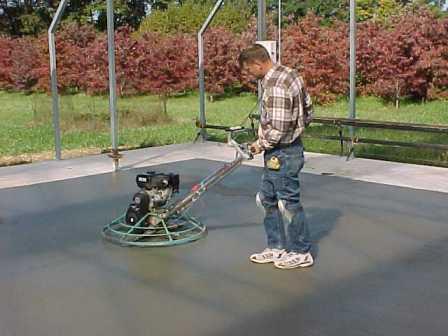Power float
A power float is a hand-operated machine used to produce a smooth, dense and level surface finish to insitu concrete beds. Power floating eliminates the time and materials needed to apply a finishing screed and is quicker and less labour-intensive process than hand trowelling.
Power floats have an electric motor or petrol engine fixed over a circular pan or skimmer which smooths concrete before hardened steel reversible metal blades rotate at up to 150 rpm over the surface to create a hardened finish.
Before power floating the concrete must be left to partially set, having been leveled and tamped. The amount of setting time necessary before power floating will depend on variables such as; air temperature, humidity, the specification of the mix and so on. A rough guide for considering when to begin power floating is when walking on the surface leaves indentations of 3-4 mm. If the concrete is too wet the machine will tear up the surface, and if it is too dry, it will not be possible to trim high spots or fill low spots effectively.
Floating usually starts at one end of the slab and moves to the other. The operator holds the float at waist-height and moves backwards so that the float removes their footprints. The speed should be slow and consistent.
Once the surface has been floated, the blades are angled to suit the concrete and achieve the specified finish. Blade angles of around 5-10 degrees are usual, but these may need to be increased after each pass over the surface.
[edit] Related articles on Designing Buildings Wiki
- Breaker.
- Cement.
- Compressed air plant.
- Concrete.
- Concrete vs. steel.
- Concreting plant.
- Laser screed.
- Screed.
- Tremie.
- Types of floor.
- Types of flooring.
[edit] External references
- Speedcrete - Power floating tips
- ‘Building Construction Handbook’ (6th ed.), CHUDLEY, R., GREENO, R., Butterworth-Heinemann (2007)
Featured articles and news
Delivering for tenants; National Retrofit Hub
New report offers recommendations to strengthen energy efficiency standards to protect private renters.
Government consultations for the summer of 2025
A year of Labour, past and present consultations on the environment, the built environment, training and tax.
CMA competitiveness probe of major housing developers
100 million affordable housing contributions committed with further consultation published.
Homes England supports Greencore Homes
42 new build affordable sustainable homes in Oxfordshire.
Zero carbon social housing: unlocking brownfield potential
Seven ZEDpod strategies for brownfield housing success.
CIOB report; a blueprint for SDGs and the built environment
Pairing the Sustainable Development Goals with projects.
Types, tests, standards and fires relating to external cladding
Brief descriptions with an extensive list of fires for review.
Latest Build UK Building Safety Regime explainer published
Key elements in one short, now updated document.
UKGBC launch the UK Climate Resilience Roadmap
First guidance of its kind on direct climate impacts for the built environment and how it can adapt.
CLC Health, Safety and Wellbeing Strategy 2025
Launched by the Minister for Industry to look at fatalities on site, improving mental health and other issues.
One of the most impressive Victorian architects. Book review.
Common Assessment Standard now with building safety
New CAS update now includes mandatory building safety questions.
RTPI leader to become new CIOB Chief Executive Officer
Dr Victoria Hills MRTPI, FICE to take over after Caroline Gumble’s departure.
Social and affordable housing, a long term plan for delivery
The “Delivering a Decade of Renewal for Social and Affordable Housing” strategy sets out future path.
A change to adoptive architecture
Effects of global weather warming on architectural detailing, material choice and human interaction.
The proposed publicly owned and backed subsidiary of Homes England, to facilitate new homes.
How big is the problem and what can we do to mitigate the effects?
Overheating guidance and tools for building designers
A number of cool guides to help with the heat.
The UK's Modern Industrial Strategy: A 10 year plan
Previous consultation criticism, current key elements and general support with some persisting reservations.
Building Safety Regulator reforms
New roles, new staff and a new fast track service pave the way for a single construction regulator.


























